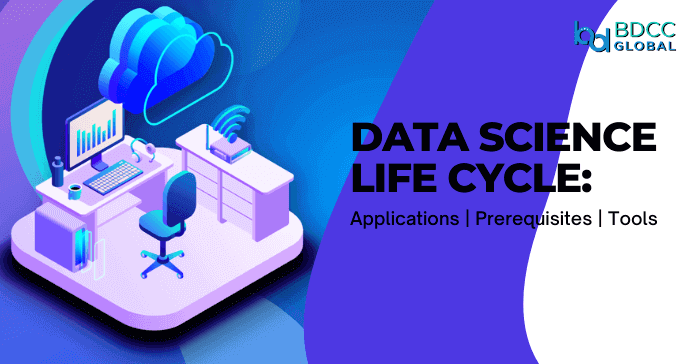
Do you ever wonder how companies like Amazon, Netflix, and Google analyze massive amounts of data to deliver personalized recommendations and insights? If yes, then have you heard of the Data Science Life cycle?
In this blog, we will explore the six stages of this structured approach, its prerequisites, and the tools that can be used to make the process more efficient. So, are you ready to dive into the world of Data Science and uncover the secrets behind big data analysis? Let’s begin!
What is Data Science?
Data Science is an interdisciplinary field that involves extracting, analyzing, and interpreting large, complex, and diverse data sets using statistical and machine learning techniques. It combines various disciplines such as mathematics, statistics, computer science, and domain-specific knowledge to gain insights from data that can be used to inform decision-making.
Did you know that Data Science has been dubbed the “sexiest job of the 21st century” by Harvard Business Review?
With the explosive growth of data today, businesses realize the immense value that can be extracted from analyzing data. The Big Data Life cycle provides a structured framework for businesses to derive insights from their data and make data-driven decisions. So, whether you’re a seasoned data professional or just starting, understanding this Life cycle is essential to stay ahead in this exciting field.
Data Science Life Cycle Applications
The Big Data Life cycle consists of six stages with activities and deliverables. Each step is crucial for accurately analyzing and understanding data. These steps are interconnected and require specialized knowledge and tools. Organizations can unlock the power of data and gain a competitive edge by adhering to best practices at each stage.
Problem Identification
The initial stage of the Data Science Life cycle requires the identification of the business problem that needs to be addressed. This involves understanding the problem, available data, and potential solutions.
Data Collection
Once the problem has been identified, the next stage involves collecting the data needed to solve the problem. This can involve a variety of sources, such as internal data sources, third-party data providers, and public data sets.
Data Preparation
After the data has been collected, it needs to be cleaned, transformed, and organized into a format that can be analyzed. This stage involves data cleaning, data transformation, and data integration.
Data Analysis
In this stage of the Data Science Life cycle, statistical and machine learning techniques are applied to the data to uncover patterns, trends, and insights. This can involve data visualization, exploratory data analysis, and hypothesis testing.
Model Building
Once the data has been analyzed, the next stage involves building predictive models that can be used to make predictions about future outcomes. This can involve building machine learning models, statistical models, or a combination of both.
Deployment
In the final stage of the Data Science Life cycle, the model is deployed into a production environment, allowing it to generate real-time predictions. This can involve deploying the model to a web application, an API, or an automated system.
Prerequisites for working in Data Science
To work in this field, there are several prerequisites that you need to have. These include:
Strong programming skills
Proficiency in programming languages such as Python, R, SQL, and Java is a prerequisite for Data Science.
Mathematical and statistical skills
In addition to programming skills, Data Science requires proficiency in mathematical and statistical techniques for analyzing large data sets. Therefore, you must understand calculus, linear algebra, probability, and statistics well.
Domain expertise
It involves working with data from various finance, healthcare, and marketing domains. Therefore, having domain expertise in a particular field can be an advantage.
Data visualization skills
Data visualization is an important aspect of Data Science, as it helps to communicate insights effectively. Therefore, you need to have skills in data visualization tools such as Tableau, Power BI, and ggplot.
Tools for Data Science
There are several tools that can be used for this interdisciplinary field, each with its strengths and weaknesses.
Python: Python is a popular programming language for Data Science. It has many libraries for data manipulation, data visualization, and machine learning, such as pandas, Matplotlib, and scikit-learn. Python is easy to learn, and many users contribute to its libraries and tools.
R: R is another popular programming language for this Data Engineering field. It has many libraries for statistical analysis, data visualization, and machine learning, such as ggplot, dplyr, and caret. R is a programming language specifically designed for statistical computing, containing numerous built-in statistical functions.
Tableau: Tableau is a user-friendly data visualization tool that enables users to create interactive visualizations and dashboards without requiring programming skills. Tableau can connect to various data sources, and its drag-and-drop interface makes it easy to create visualizations.
SQL: SQL is a database query language used in Data Science to extract data from databases. SQL is fast, efficient, and can handle large data sets.
Jupyter Notebook: Jupyter Notebook is an open-source web application that allows you to create and share documents that contain live code, equations, visualizations, and narrative text. It supports several programming languages, including Python, R, and SQL. Jupyter Notebook is a great tool for data exploration, prototyping, and sharing results.
Conclusion
The Data Science Life cycle is a comprehensive framework that can help businesses extract insights and value from their data. Following this structured approach, companies can make data-driven decisions to improve their bottom line. However, you must have a strong foundation in programming, statistics, and domain expertise to work with this methodology. So, are you ready to take on the challenge and explore the exciting world of Data Science? With the right skills and tools, the possibilities are endless!
BDCC
Latest posts by BDCC (see all)
- Cloud computing in healthcare: Uses and benefits - June 23, 2025
- What are the Best Practices for Terraform File Structure? - June 10, 2025
- From Monolith to Microservices: DevOps Strategies For a Smooth Transition - June 5, 2025

